Administering Microsoft System Center Configuration Manager and Cloud Services Integration v1.0
Question 1
You have a deployment of System Center Configuration Manager (Current Branch) that contains a single primary server named CM01. CM01 is configured as a distribution point.
The main office of your company has multiple floors. Each floor has a VLAN and a subnet.
A DHCP server named DC01 currently hosts all the DHCP scopes.
You need to ensure that you can use Configuration Manager to deploy operating systems to the client computers on each floor by using the PXE.
Which two actions should you perform? Each correct answer presents part of the solution.
NOTE: Each correct selection is worth one point.
- A. Configure option 60 for each DHCP scope.
- B. Use the Configuration Manager console to distribute the boot image to CM01.
- C. Add the IP address of CM01 to the IP Helper of each VLAN.
- D. Copy the RemoteInstall folder to CM01.
Answer : CD
References:
https://docs.microsoft.com/en-us/sccm/osd/deploy-use/use-pxe-to-deploy-windows-over-the-network https://4sysops.com/archives/if-pxe-boot-fails-with-sccm-2012/#dhcp-or-ip-helper-for-pxe-across-subnets
Question 2
DRAG DROP -
Your network contains an Active Directory forest named adatum.com. The forest has a deployment of System Center Configuration Manager (Current Branch).
You create two users named User1 and User2 in adatum.com.
You plan to delegate the following tasks:
-> User1 must be able to create user collections.
-> User2 must be able to import driver packages.
You need to add User1 and User2 to security roles. The solution must use the principle of least privilege.
To which security role should you add each user? To answer, drag the appropriate roles to the correct users. Each role may be used once, more than once, or not at all. You may need to drag the split bar between panes or scroll to view content.
NOTE: Each correct selection is worth one point.
Select and Place:
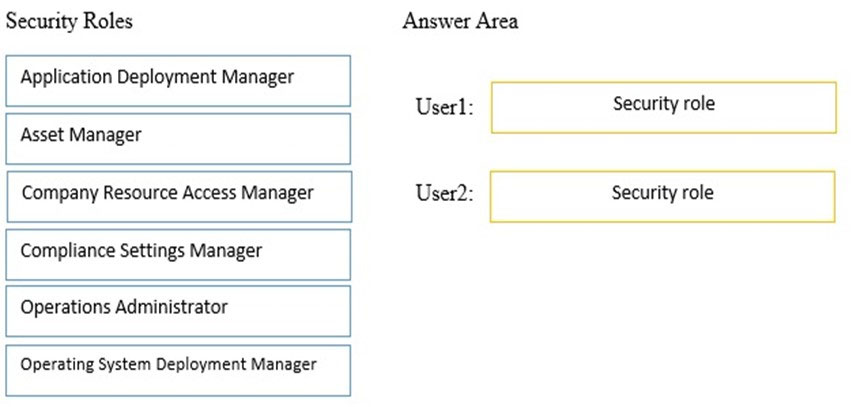
Answer : 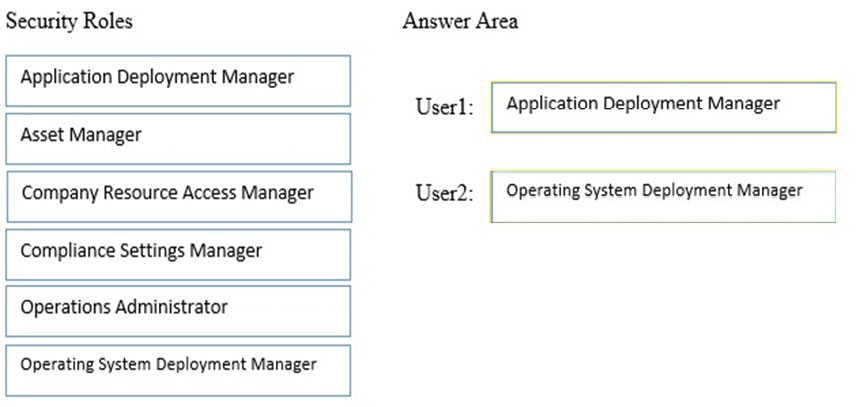
Explanation:
User1: Application Deployment Manager
Application Deployment Manager grants permissions to deploy applications. Administrative users who are associated with this role can view a list of applications, and they can manage deployments for applications, alerts, templates and packages, and programs. Administrative users who are associated with this role can also view collections and their members, status messages, queries, and conditional delivery rules.
User2: Operating System Deployment Manager
Operating System Deployment Manager grants permissions to create operating system images and deploy them to computers. Administrative users who are associated with this role can manage operating system installation packages and images, task sequences, drivers, boot images, and state migration settings.
References:
https://blogs.technet.microsoft.com/hhoy/2012/03/06/role-based-administration-in-system-center-2012-configuration-manager/ https://techcommunity.microsoft.com/t5/Configuration-Manager-Archive/Introducing-Role-Based-Administration-in-System-Center-2012/ba-p/272974
Question 3
You have a deployment of System Center Configuration Manager (Current Branch).
You need to collect detailed usage data from devices. The usage data must be retained for three years.
What should you deploy?
- A. A Microsoft Operations Management Suite (OMS) connector
- B. Software update point switching
- C. Server groups
- D. A Data Warehouse service point.
Answer : D
References:
https://docs.microsoft.com/en-us/sccm/core/servers/manage/data-warehouse
Question 4
HOTSPOT -
Your network contains an Active Directory forest named adatum.com.
A stand-alone primary System Center Configuration Manager (Current Branch) site named S01 is deployed to adatum.com.
The Configuration Manager deployment includes the servers shown in the following table.

You perform regular site backups by using Configuration Manager.
You have a test environment that contains the servers shown in the following table.

The test environment has a domain controller that hosts a copy of the adatum.com forest.
You plan to recover Configuration Manager in the test environment.
You need to prepare the test environment to support the planned recovery.
How should you complete each action? To answer, select the appropriate options in the answer area.
NOTE: Each correct selection is worth one point.
Hot Area:
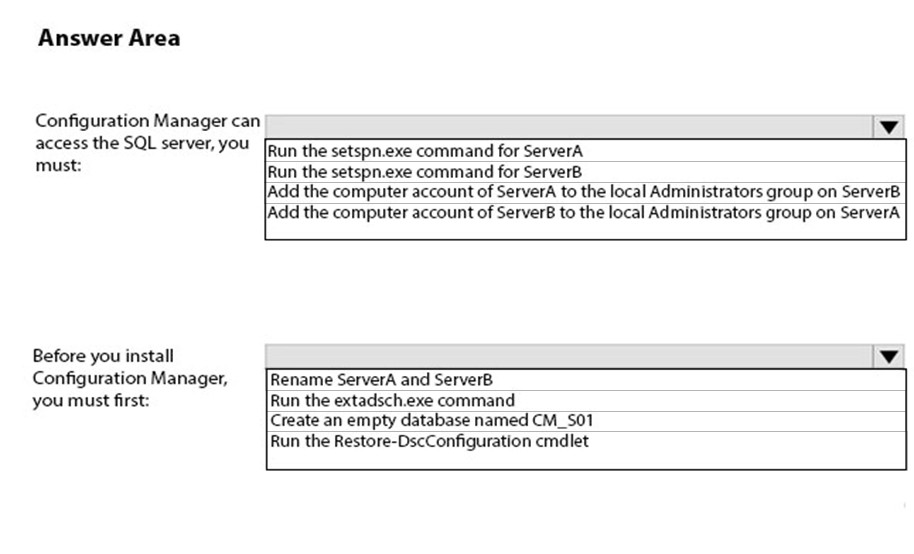
Answer : 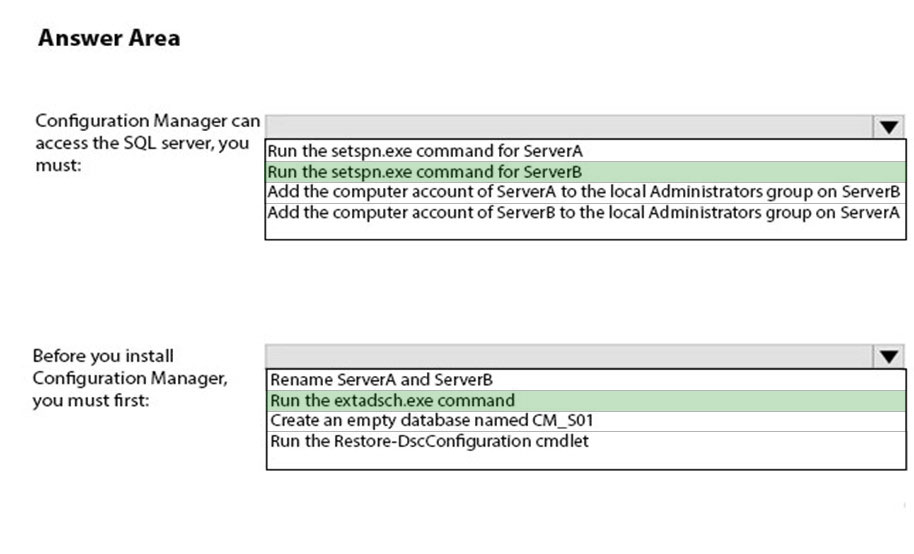
References:
https://docs.microsoft.com/en-us/sql/database-engine/configure-windows/register-a-service-principal-name-for-kerberos-connections?view=sql-server-
2017#Manual
https://docs.microsoft.com/en-us/sccm/core/get-started/set-up-your-lab
Question 5
You have a deployment of System Center Configuration Manager (Current Branch).
You have offices in Montreal and Seattle.
You need to deploy software to the client computers in the Montreal office only.
What should you do first?
- A. Create an Active Directory container.
- B. Create a user collection that contains the users in the Montreal office.
- C. Configure a boundary group for client assignment.
- D. Create a boundary for the Montreal office that uses IP subnets.
Answer : D
References:
https://docs.microsoft.com/en-us/sccm/core/servers/deploy/configure/define-site-boundaries-and-boundary-groups
Question 6
You have a deployment of System Center Configuration Manager (Current Branch).
The domain contains the users shown in the following table.
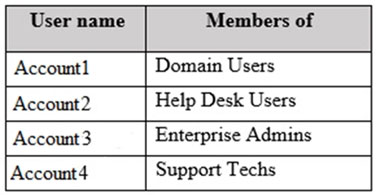
Support Techs is a member of the Administrators group on each client computer. Help Desk Users is a member of the Power Users group on each client computer.
You need to deploy Configuration Manager agents by using a client push installation. The solution must use the principle of least privilege.
Which user should you configure as the client push installation account?
- A. Account1
- B. Account2
- C. Account3
- D. Account4
Answer : D
References:
https://technet.microsoft.com/en-us/library/bb632779.aspx
Question 7
Your company has a main office and a branch office. The branch office connects to the main office by using a VPN over DSL connection.
The branch office contains 500 client computers that run Windows 8.1. All the computers are on the same subnet.
You plan to upgrade the operating system on the computers by using Configuration Manager. During the upgrade process, you will maintain the user state and the files.
You need to recommend a solution to reduce the amount of WAN traffic during the operating system deployments.
What should you include in the recommendation?
- A. a cloud management gateway
- B. a distribution point
- C. a service connection point
- D. a cloud-based distribution point
Answer : B
References:
https://docs.microsoft.com/en-us/sccm/core/servers/deploy/configure/deploy-and-manage-content#bkmk_distribute
Question 8
Your company has a main office and a branch office.
You have a deployment of System Center Configuration Manager (Current Branch).
The main office has a software update point. Currently, all client computers receive Microsoft updates from the main office.
You need to ensure that the computers in the branch office receive updates from a local server. The solution must meet the following requirements:
-> Ensure that the updates are managed by using Configuration Manager.
-> Ensure that the computers in the branch office scan for updates against a local catalog.
What should you deploy to the branch office?
- A. a software update point, a service connection point, and an Application Catalog website point
- B. a software update point, a distribution point, and a reporting services point
- C. Windows Server Update Services (WSUS), a service connection point, and a management point
- D. Windows Server Update Services (WSUS), a software update point, and a distribution point
Answer : D
References:
https://docs.microsoft.com/en-us/sccm/sum/get-started/manage-settings-for-software-updates https://docs.microsoft.com/en-us/sccm/sum/deploy-use/download-software-updates
Question 9
Your company has a main office and a branch office. The branch office connects to the main office by using a VPN over DSL connection.
The branch office contains 500 client computers that run Windows 8.1. All the computers are on the same subnet.
You plan to upgrade the operating system on the computers by using Configuration Manager. During the upgrade process, you will maintain the user state and the files.
You need to recommend a solution to reduce the amount of WAN traffic during the operating system deployments.
What two components should you include in the recommendation? Each correct answer presents part of the solution.
NOTE: Each correct selection is worth one point.
- A. a cloud management gateway
- B. a distribution point
- C. a cloud-based distribution point
- D. a fallback status point
- E. a management point
- F. a state migration point
Answer : BE
References:
https://docs.microsoft.com/en-us/sccm/core/servers/deploy/configure/install-and-configure-distribution-points
Question 10
You have a deployment of System Center Configuration Manager (Current Branch) that was implemented by a user named Admin1.
Configuration Manager includes the administrative users shown in the following table:
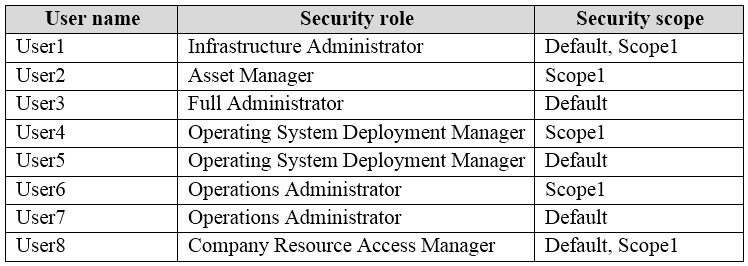
You add a boot image named Boot1 to Configuration Manager. You set the security scope of Boot1 to Scope1.
Which user can create a task sequence that uses Boot1?
- A. User8
- B. User3
- C. User6
- D. User1
- E. User2
- F. User5
- G. User7
- H. User4
Answer : C
References:
https://technet.microsoft.com/en-us/library/gg682108.aspx
Question 11
You have a deployment of System Center Configuration Manager (Current Branch).
The manufacturing department has 100 client computers that run Windows 10. The computers are prevented from accessing the Internet.
You purchase a new Microsoft Store for Business app named App1 that is licensed for offline use.
How should you deploy App1 to the client computers?
- A. Configure synchronization between Configuration Manager and the Microsoft Store for Business.
- B. Install App1 from the Microsoft Store for Business on a client computer that has access to the Internet.
- C. Extract the APPX file to a folder that can be accessed by using Configuration Manager.
- D. Configure the account settings to show offline-licensed apps.
- E. Create an application in the Software Library.
- F. Configure the Application Catalog website point.
Answer : A
Explanation:
The Microsoft Store for Business is where you find and acquire Windows apps for your organization. When you connect the store to Configuration Manager, you then synchronize the list of apps you've acquired. View these apps in the Configuration Manager console, and deploy them like you deploy any other app.
The Microsoft Store for Business supports two types of app:
-> Online: This license type requires users and devices to connect to the store to get an app and its license. Windows 10 devices must be Azure Active Directory
(Azure AD)-joined or hybrid Azure AD-joined.
-> Offline: This type lets you cache apps and licenses to deploy directly within your on-premises network. Devices don't need to connect to the store or have a connection to the internet.
References:
https://docs.microsoft.com/en-us/sccm/apps/deploy-use/manage-apps-from-the-windows-store-for-business
Question 12
You have a deployment of System Center Configuration Manager (Current Branch).
You have offices in Montreal and Seattle. Each office is configured as an Active Directory site. Objects in each office are part of a device collection.
You need to deploy software to clients in the Montreal office from servers in the Montreal office only.
What should you do?
- A. Create an organization unit (OU) in Active Directory for the users in the Montreal office.
- B. Create a boundary for the Montreal office that uses Active Directory sites.
- C. Add a secondary site in Configuration Manager for the Montreal office.
- D. Create a user collection that contains the users in the Montreal office.
- E. Create an Active Directory container.
- F. Create a boundary for the Montreal office that uses IP subnets.
Answer : B
References:
https://www.systemcenterdudes.com/configure-sccm-2012-boundaries/
Question 13
You have a deployment of System Center Configuration Manager (Current Branch).
You have offices in Montreal and Seattle. Each office is configured as an Active Directory site. Objects in each office are part of a device collection.
You need to deploy software to clients in the Montreal office from servers in the Montreal office only.
What should you do?
- A. Configure a boundary group for the client assignment.
- B. Create a boundary for the Montreal office that uses Active Directory sites.
- C. Add a management point in the Montreal office.
- D. Create a user collection that contains the users in the Montreal office.
Answer : B
Reference:
https://www.systemcenterdudes.com/configure-sccm-2012-boundaries/
Question 14
Note: This question is part of a series of questions that present the same scenario. Each question in the series contains a unique solution that might meet the stated goals. Some question sets might have more than one correct solution, while others might not have a correct solution.
After you answer a question in this section, you will NOT be able to return to it. As a result, these questions will not appear in the review screen.
Your company uses a network ID of 10.0.0.0/8.
The company opens a new office that uses a network ID of 10.5.0.0/16. The office has three floors. Each floor has a VLAN. The network ID of each VLAN is
10.5.10.0/24, 10.5.20.0/24, and 10.5.30.0/24.
You create a distribution point for the new office.
You plan to distribute content to clients in the new office from the new distribution point.
You need to create a boundary for the new office.
Solution: Create an IP subnet boundary for 10.5.0.0/16.
Does this meet the goal?
- A. Yes
- B. No
Answer : A
References:
https://docs.microsoft.com/en-us/sccm/core/servers/deploy/configure/boundaries
Question 15
You have a deployment of System Center Configuration Manager (Current Branch).
Your company has a main office and a branch office. The branch office has five users. Some users use laptops and some users use desktop computers.
All the servers for the company are located in the main office. The branch office connects to the main office by using a site-to-site VPN.
You need to minimize the bandwidth used to deploy updates to branch office clients over the VPN connection. The solution must minimize costs.
What should you configure in the branch office?
- A. a distribution point
- B. a cloud management gateway
- C. a service connection point
- D. a cloud-based distribution point
Answer : A
References:
https://docs.microsoft.com/en-us/sccm/core/plan-design/hierarchy/design-a-hierarchy-of-sites